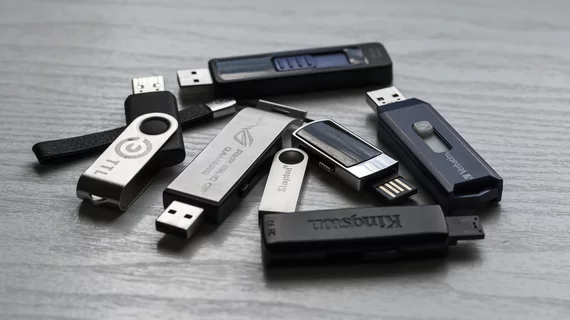Blast from the past: USB drives make impact on AI development
Working closely with AI has led researchers from one institution to embrace a familiar piece of technology that may surprise many of their peers: the USB drive. The team wrote about its experience in the Journal of Digital Imaging.
“There are major challenges in Canada when developing novel artificial intelligence algorithms using healthcare data,” wrote William Parker, University of British Columbia in Vancouver, Canada, and colleagues. “Simple tasks such as downloading a file from the internet or sending an email from a hospital computer become as challenging as solving the Rubik’s cube. Firewalls, forgotten passwords, app restrictions and administrator permissions plague our computers to the point of hardly being useful.”
USB drives helped the team address these challenges. One example of the technology’s usefulness was how it helped Parker et al. physically bring a completed algorithm to a hospital so that it could be used. The algorithm, designed to identify pneumonia on chest x-rays, was trained by the researchers on their own computer system. Once it was ready to be tested in a clinical environment, however, they couldn’t proceed.
“The hospital computer firewalls and administrator restrictions limited our ability to install new software,” the authors wrote. “We also could not build a web app (website) because data was not allowed to be used in the cloud. Our center restricted data use to on premise only. Further, it was not convenient for our radiologists to visit our lab as it was a 20-minute drive away from where they practice.”
USB drives “saved the day” for Parker and colleagues. The authors encrypted their entire neural network onto a single USB, making it easy for radiologists to test the algorithm’s accuracy and then provide feedback so that it could be improved. With the .exe file never being installed into an actual hospital computer, “there was no risk of affecting the hospital systems or slowing the system computer efforts.”
This feedback paid off immediately, leading to significant “accuracy improvements” that could one day lead to critical improvements in patient care.
The authors did acknowledge that their process was far from perfect. The algorithm’s efficiency is hurt by not being directly installed onto a hospital’s computer, for example, and it can’t be used for “live interpretation” when it’s left on a basic USB drive. Ultimately, though, the team found that this older piece of technology was able to make a world of difference.
“If these institutional issues resonate with you, a USB stick might be the answer to all of your problems too,” they concluded.

